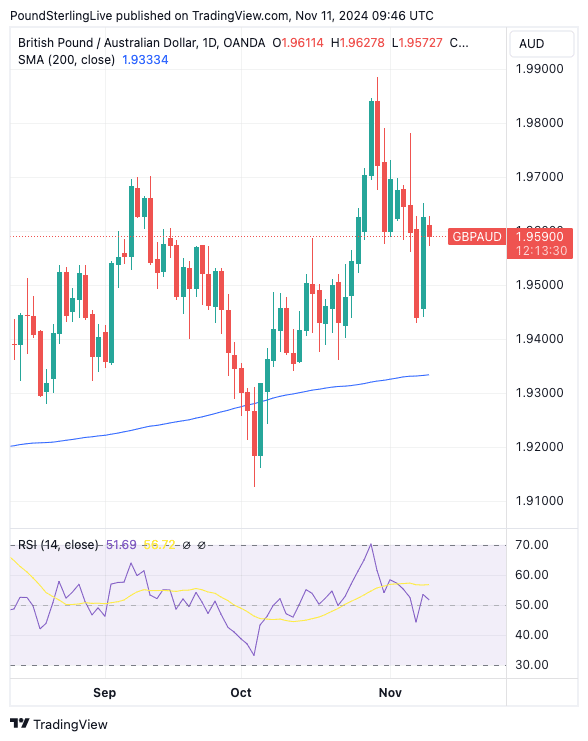
Above: RBA Governor Bullock speaks this week.
The Pound to Australian Dollar exchange rate (GBP/AUD) is forecast to maintain an upward bias in the coming five days. Risks include UK and Aussie labour market data releases and U.S. inflation midweek.
One of the big surprises of the previous week's excitement around the U.S. elections was the strength displayed by the Australian Dollar.
The playbook said the Aussie would be one of the big losers of a strong showing by Trump and his Republicans because of the risks posed by such an outcome to the Chinese economy.
Yet, the Aussie Dollar rocketed higher as it became clear Trump had scored an historic win, boosted by rising equity markets.
This confirms that the uplift in global investor sentiment following the election outcome outweighed any concerns pertaining to China.
GBP/AUD sunk 0.24% on the day and lost a further 0.80% on Thursday, putting the pair at risk of further downside in the event that the 'Trump trade' continues for some time.
Yet, by Friday, GBP/AUD had recovered the post-election losses, and the exchange rate is now back to where it was prior to election day.
The recovery tells us that 1) the Trump trade is not necessarily all-out constructive for AUD, and 2) China still matters.
Regarding point 2, Friday saw a key planning body in China announce a long-awaited stimulus that turned out to be something of a damp squib , and the Australian Dollar let this be known by falling sharply.
The National People’s Congress (NPC) on Friday announced a 10 trillion yuan debt-swap programme that would sterilise hidden debts over the next five years.
"The initial market reaction was disappointment, with crude oil, copper and iron ore prices as well as A50 futures falling," says Duncan Wrigley, Chief China Economist at Pantheon Macroeconomics.
China was expected to unleash a package aimed at bolstering the Chinese economy, which would, in turn, bolster the prospects of China-linked assets, such as Australia's Dollar.
The NPC timed its decision to follow the U.S. election result, with investors thinking a bigger support package would be unleashed in response to a 'red sweep'.
"Investors had been hoping for a large-scale stimulus involving consumption-promotion measures. This isn’t a measure to provide a sudden big boost to domestic demand, but rather seeks to tackle structural issues, thereby enabling local governments to ramp up spending gradually over several years," adds Wrigley.
The net result is a GBP/AUD exchange rate that still holds a mild upward bias.
From a technical perspective, the odds of consolidation around the 21-day moving average are high (1.9575) and the level could offer some support in the coming days. The 21 DMA is pointed higher, which advocates for upside and a return to 1.9591.
UK data will be of interest this week, with Tuesday's labour market data being the highlight.
The market looks for average earnings to have declined to 4.7% in September, with the figure falling to 3.9% for earnings with bonuses included. The unemployment rate is expected to have risen slightly to 4.1%.
Anything below this could prove a setback to Pound Sterling.
In Australia, Wednesday's wage figures will attract some attention, given they could influence when the Reserve Bank of Australia (RBA) cuts interest rates. Markets look for quarterly wage numbers to have risen 0.9% on a quarterly basis, taking the annual increase to 3.6%.
Anything less could see AUD pressured.
Thursday is busy, with RBA governor Michelle Bullock due to speak and Aussie employment numbers due.
As always, markets will parse Bullock's address for any sign the RBA might consider cutting rates ahead of year-end. For now, this is an unlikely development given the Governor still thinks Aussie inflation remains too high and the labour market too tight.
With this in mind, strong labour market data would push out the start of the RBA cutting cycle, bolstering AUD in the process.
The market anticipates the Aussie unemployment rate will rise to 4.2%, despite an increase in employment of 25K.
Although interest is high in both Australia and the UK this week, the midweek release of U.S. inflation numbers could stir GBP/AUD.
As mentioned, AUD is particularly sensitive to broader investor sentiment, and U.S. inflation numbers will be key to how markets perform this week.
The expectation is for a reading of 0.2% month-on-month and 2.6% year-on-year. Anything more could cause the USD to catch a bid and markets to fall, which would weigh on the AUD.
However, there has been a significant repricing away from Federal Reserve rate cuts during October as investors prepare for U.S. economic outperformance, with the market now seeing a limited number of cuts forthcoming in 2025.
We think delivering a material reduction in rates would take a significant upside surprise for the USD. This is because a large part of the reduction in rate cut bets has already taken place, and it is difficult to see too much by way of USD upside in response.
Instead, the bigger reaction could follow a softer-than-forecast outcome, given that markets now have more space to rebuild rate cut bets.
This suggests there is greater scope for AUD upside on below-consensus figures.

